KS-1 "Comet" anti-ship missile: the first of its kind
In the first post-war years, our country studied the scope of missile weapons and its development. Based on the results of these works, the possibility was found of creating a promising anti-ship missile for bombers. In 1947, the corresponding resolution of the USSR Council of Ministers was issued, and a few years later the ready-made KS-1 Comet complex was put into service.
Particularly important task
Decision of the Council of Ministers on the establishment aviation RCC with a firing range of at least 100 km came out on September 8, 1947. A project with the code "Comet-3" was commissioned to develop several organizations.
OKB-51 was supposed to make the rocket, but soon the work was assigned to A.I. Mikoyan. The guidance and control system for the rocket was designed by the newly created Special Bureau No. 155, headed by P.N. Kuksenko. OKB-1 A.N. worked on systems for a missile carrier. Tupolev. Also involved in the work of a host of other scientific and design organizations.
Look for the look
Work on "Comet-3" was carried out in OKB-155 under the code "B"; led by M.I. Gurevich. Even while searching for basic solutions, the customer demanded that the rocket be equipped with a turbojet engine and its range increased. The consequence of this was the proposal to build anti-ship missiles based on the existing fighter jet.
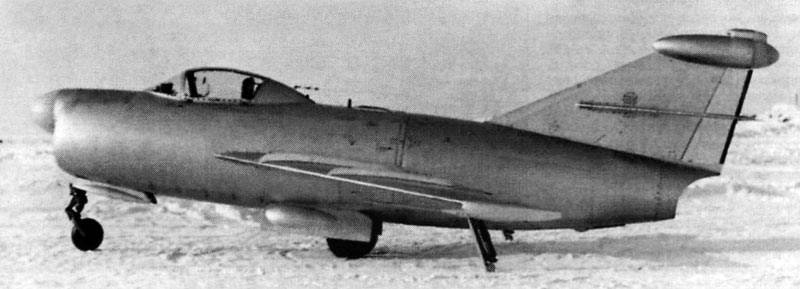
One of the analogue aircraft "K". Photo Militaryrussia.ru
At first, the I-300 (MiG-9) aircraft was considered as the basis for the Comet in a simplified version. Then they worked on a similar alteration of the newer I-310 (MiG-15) aircraft, and this option turned out to be more successful. Nevertheless, to fulfill all the requirements, it was necessary to create a completely new design - albeit on the basis of the old developments.
At the search stage, flying laboratories based on existing equipment were actively used. The carrier equipment was tested on a transport Li-2, and rocket devices were tested on a MiG-9. By the beginning of 1951, the first of four K-type aircraft appeared. By its design, it looked like the future RCC, but was distinguished by the presence of a cabin, wing mechanization and retractable landing gear. According to its performance characteristics "K" repeated the designed missile.
On 4 on January 1951, test pilot Amet Khan Sultan completed his first flight on the K-1, taking off from the ground. In the spring, OKB-156 provided the Tu-4KS bomber with equipment for suspending a rocket or analogue aircraft. The first flight “K” with discharge from the carrier was performed in May of the same year. Soon three more laboratories with numbers from two to four came out for testing.
Until May 1952, four analogue aircraft completed approx. 150 flights with horizontal take-off or discharge from the Tu-4. The issues of aerodynamics, general aircraft systems, guidance tools, etc. were worked out. Successful testing of “K” products made it possible to form the final look of the promising RCC “Comet-3”, as well as to begin preparations for testing such weapons.
Product "Comet"
Ready-made rocket KS-1 "Comet" was an aircraft shell, externally and in layout similar to the MiG-15 fighter. The differences were in smaller sizes (length 8,3 m and wing span 4,77 m), weight (2760 kg), increased sweep of the wing, etc.
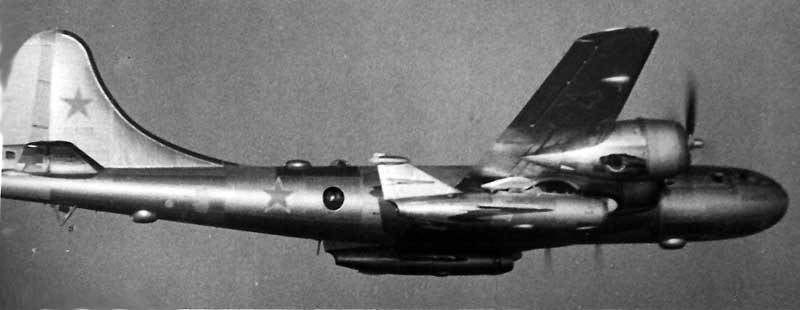
Aircraft carrier Tu-4KS with "K" under the wing. Photo Militaryrussia.ru
As a power plant on the KS-1, the RD-500 turbojet engine was used. It was proposed to take aircraft engines with an expired resource, carry out major repairs and put them on missiles. RCC did not need an engine with a full resource, and this approach allowed to save considerably.
Later, a simplified and lightweight short-life modification of the RD-500K engine appeared on the basis of cheaper materials and without the possibility of traction control. The later KS-1 series were equipped only with special RD-500K.
RCC received a guidance system type K-1. It included a semi-active radar seeker in the bow, a tail pin antenna and signal processing equipment with the issuance of commands to the actuators. The rocket devices were supposed to receive radio signals from the carrier radar.
In the central part of the glider was located a high-explosive warhead K-450 with 500-kg charge. This was enough to destroy ships of all major classes.
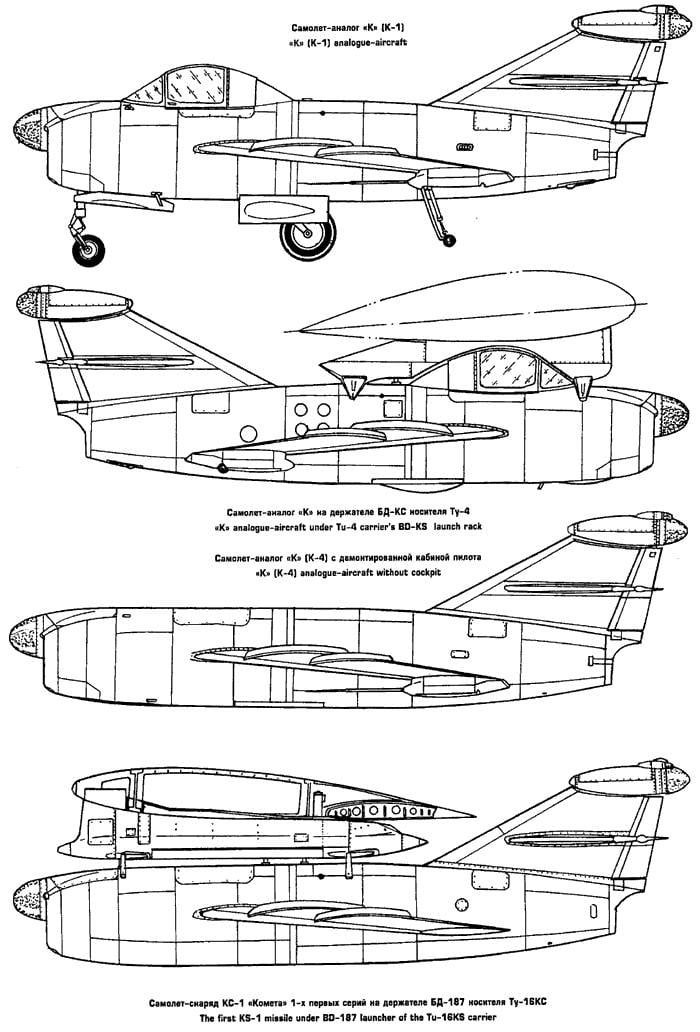
The analogue aircraft "K" and the cruise missile KS-1. Figure Airwar.ru
Initially, the KS-1 carrier was the Tu-4KS long-range bomber, which received a set of special equipment. It installed the K-1M Cobalt-M radar, missile control equipment, an operator console and two beam holders under the wing.
Principle of operation
The principle of operation of the missile system was quite simple. A carrier aircraft from a distance of 90-100 km with the help of a radar had to find a surface target and take it for auto tracking. At a distance of approx. 90 km was reset. After launch, the rocket reached its maximum speed and reached a height of 400 m, remaining in the beam of the carrier’s radar. At a distance of no more than 30 km from the target, the GOS could capture the radio signal reflected by the target and direct the missile at it. Before hitting the target, the rocket went into a dive.
The booster plane had to illuminate the target until the missile hit, after which it could leave the target area. Depending on its performance characteristics, at the time the missile hit, the bomber had to remain at a distance of tens of kilometers from the target, which excluded its defeat by air defense systems of that time.
On the trajectory "Comet" developed a speed of at least 1000 km / h. The firing range was originally 90 km. Starting height - no more than 4-4,5 km.
KS-1 in trials
In May 1952, after the completion of testing the K aircraft, the first launch of the KS-1 missile from the Tu-4KS took place. Due to malfunctions, the missile did not go into the radar beam and fell into the sea. The following launches were also unsuccessful, one of them ended in damage to the carrier aircraft. As a result of this, a difficult refinement of the product was required.

Tu-4KS with two missiles. Photo Militaryrussia.ru
State trials began in July 1952 and ended in January 1953. They used 12 missiles; the training target was the decommissioned cruiser "Red Caucasus". The bulk of the launches was carried out with a weighted simulator warhead - for the safety of the target. However, the kinetic energy of the rocket was enough to hit the target. Whether the armor belt made its way through is not clear. From 12 missiles, 8 hit the target.
21 November 1952 was the last launch on the cruiser. The target without a crew was traveling at a speed of 18 knots. The bomber found it at a distance of 120 km and launched the "Comets" from 80 km. A rocket with warhead hit the target and exploded. The ship received fatal injuries and sank in a few minutes.
In the series and in the troops
Already in 1952, the 2 OKB-155 branch established mass production of new missiles, and at the beginning of the 1953, the Comet was adopted. The developers of the project received the Stalin Prize.
In 1953, production cooperation on KS-1 was significantly rebuilt. New enterprises were involved in the production program, which allowed to increase the pace of production.
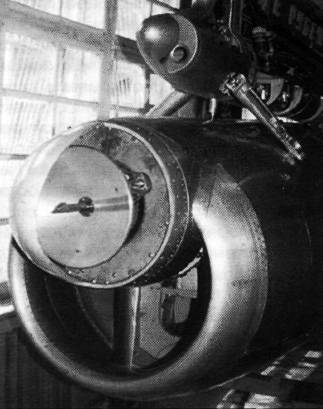
Layout "Comet" with a transparent fairing. The GOS antenna is visible. Photo Militaryrussia.ru
In the same year, in Crimea, a training unit No.27 was formed, which received Tu-4KS and RCC KS-1 aircraft. The personnel of the unit had to master a new material part and work out the features of its application. Within two years, 18 training launches (14 hits) were made, on the basis of which they compiled instructions on the combat use of missiles.
In August 1955, part No.27 was reorganized into the 124 heavy long-range bomber regiment. In addition to the converted Tu-4, he received SDK-5 simulator aircraft - a modification of the MiG-17 with equipment similar to the K type. With their help, it was possible to conduct training for pilots without spending real rockets.
In parallel with these events, the Tu-4 bombers were being modernized at the Kazan Aircraft Plant. For several years, dozens of naval aviation combat vehicles were converted into carriers of anti-ship missiles fleet.
New carrier
By the time the Comet was adopted, the Tu-4 aircraft was outdated and needed to be replaced. Already in 1954, tests of the Tu-16KS bomber-rocket carrier started. The latest Tu-16 installed equipment from the Tu-4KS. At the same time, part of the control systems and the operator's workplace had to be made in the form of a container suspended in the cargo compartment. Like its predecessor, the new aircraft could carry two KS-1 missiles.
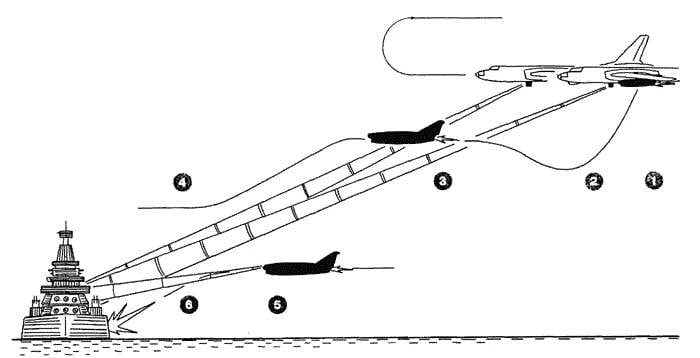
The scheme of combat use of the COP-1. Figure Rbase.new-factoria.ru
During the tests, the Tu-16KS confirmed its advantages over the Tu-4KS. He was distinguished by higher performance characteristics and had modern instrumentation. All this allowed us to more fully realize the potential of RCC. At the end of 1955, the Tu-16-based missile system was officially adopted.
By the end of the fifties, the Tu-16KS were available in naval aviation of all fleets of the USSR Navy. Their total number reached 90 units. Due to this, it was possible to abandon obsolete carriers of the mid-forties.
Rocket upgrade
In parallel with the production of new carriers, the rocket was modernized. The improved Comet could be launched at altitudes up to 7 km and flew at 130 km. Provided sequential salvo launch of two missiles with one carrier. In this case, both products flew in the same beam, but with a safe interval. A methodology for launching a rocket from an altitude of 2 km was formed. This made it easier to strike and increased the probability of hitting the target to 0,66.
In the early sixties, developed improved equipment for the KS-1 and Tu-16KS, resistant to interference. Due to this, it was possible to increase the resistance to the enemy's electronic warfare, as well as reduce the negative impact of their own electronic equipment during a massive launch.
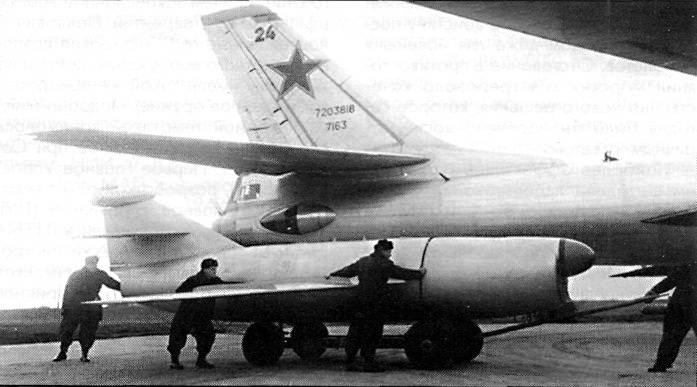
The missile suspension under the wing of the Tu-16KS. Photo Rbase.new-factoria.ru
A new modification of the "Comet" with an infrared seeker of the "Sputnik-2" type was developed. Several such missiles were made, but the direction was not developed. It turned out that the target of the “ship” type does not emit enough heat for the effective operation of the infrared seeker.
Based on the KS-1, several new missile systems were created. For cruisers, 67 Ave. developed the KSS system, which included a beam launcher and control devices. In a similar way, the S-2 land complexes Sopka (mobile) and Strela (stationary) were built. On the basis of C-2, the product KS-7 or FCR-1 was developed, which was distinguished by the use of a nuclear warhead.
Long service
Cruise missiles of the KS-1 "Comet" family have been in service since 1953. Aviation RCC appeared first. Soon after, land modifications came into service, including with special features. The complexes based on the Tu-4KS and Tu-16KS were in service with naval aviation of all fleets. Ground complexes were operated by coastal forces and the Air Force.
“Comet” was the first Russian anti-ship missile system and proved to be quite good in this capacity. However, by the mid-sixties, such weapons were outdated and new models were created to replace them. During this period, the production of new missiles and the re-equipment of the Tu-16KS under them began. Complexes with anti-ship missiles KS-1 remained in service until 1969, after which they were finally decommissioned and replaced with later systems.
Tu-16KS and missiles for them were limitedly supplied to foreign countries. Such missile systems received Egypt and Indonesia. As far as is known, the Egyptian Air Force did not manage to use the received weapons. During the Six Day War, the Israeli Air Force destroyed the entire Egyptian squadron of missile carriers right at the airport. Indonesian aircraft served for many years, but did not participate in battles.
First of its kind
The KS-1 "Comet" project was the first domestic attempt to create an anti-ship missile to combat large surface targets. In general, this attempt was successful, and naval aviation received new weapons with high performance. However, due to the imperfection of the technology of that time, Comet had a number of noticeable shortcomings.
Their correction and development of new solutions quickly led to the emergence of new, more advanced RCC. Soon they ousted the KS-1 from their arsenals, but it left a place of honor in stories domestic aviation weapons.

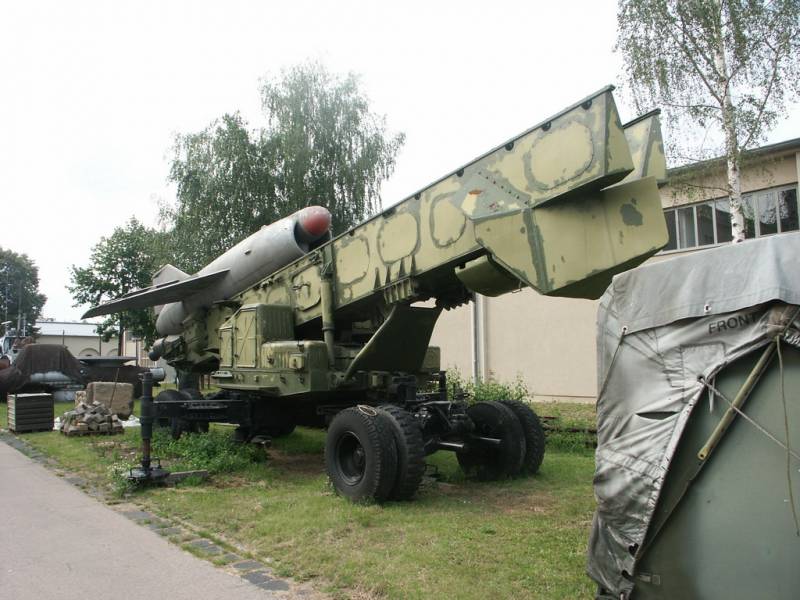
Information